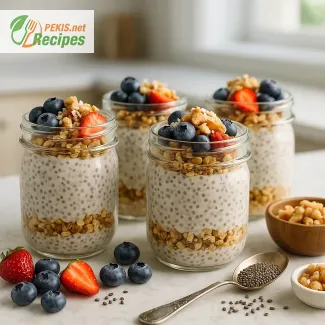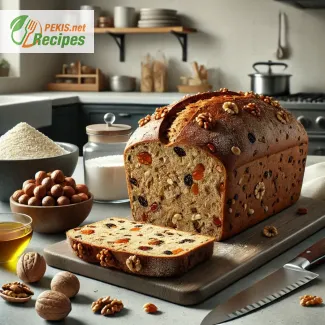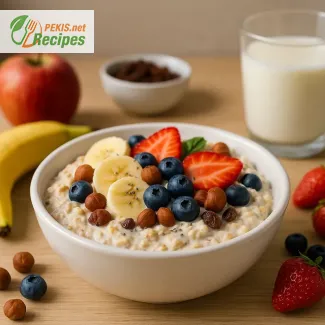
Discover the Art of Light Desserts: A Culinary Specialty to Delight Your Senses.
When it comes to satisfying a sweet tooth, light desserts are the ultimate indulgence. These creations are not just a treat for your taste buds but also a testament to the art of balancing flavor, texture, and health-conscious choices. In the world of culinary specialties, a light dessert represents sophistication and restraint, offering a luxurious experience without the heaviness of traditional sweets.
Whether you're savoring a silky panna cotta, a delicate fruit sorbet, or an airy mousse, these desserts are crafted to deliver maximum satisfaction with minimal guilt. But what makes a dessert "light"? It’s not just about calories—it’s about the thoughtful use of high-quality ingredients, careful preparation, and a focus on freshness. A truly exceptional light dessert achieves that perfect harmony where every bite feels indulgent, yet refreshingly light.
The Essence of Light Desserts: Why They’re a Culinary Masterpiece
Unlike their richer counterparts, light desserts are defined by their ability to highlight natural flavors. Imagine the burst of freshness from perfectly ripened berries in a delicate pavlova or the tangy zing of citrus in a creamy yogurt parfait. These desserts often prioritize simplicity, allowing each ingredient to shine without overpowering the palate.
Texture plays a crucial role in these confections. A light dessert may feature a cloud-like whipped cream, the smoothness of a gelatin-based treat, or the crispiness of a perfectly baked meringue. Each element is carefully balanced to create a sensory experience that is as delightful to eat as it is to behold.
Another defining characteristic is the use of alternative sweeteners or lower-fat options, which ensure that these desserts are lighter without compromising on taste. For instance, a sorbet crafted from seasonal fruits and a touch of honey can offer a sweetness that feels pure and vibrant, unlike the heavy richness of a traditional ice cream.
The Allure of Light Desserts in Fine Dining
In the realm of fine dining, light desserts often serve as the grand finale to a sumptuous meal. Chefs curate these desserts to cleanse the palate, leaving diners feeling satisfied but not weighed down. Think of a lemon tart with a whisper-thin crust or a refreshing granita served with a sprig of mint. These creations highlight the artistry and innovation that go into crafting desserts that are both memorable and approachable.
Light desserts also lend themselves to beautiful presentations, with minimalist plating that elevates their elegance. A drizzle of fruit coulis, a dusting of powdered sugar, or a scattering of edible flowers can transform even the simplest dessert into a visual masterpiece.
Why Light Desserts Are Perfect for Any Occasion
One of the reasons light desserts have become a culinary staple is their versatility. They are ideal for nearly any occasion, from casual family dinners to elaborate celebrations. Hosting a summer soirée? Serve a refreshing watermelon granita. Planning a romantic dinner? A luscious chocolate mousse with a hint of espresso strikes the perfect note. Need something festive for a holiday gathering? A delicate apple tart topped with a dollop of Greek yogurt balances richness and lightness beautifully.
Even in everyday life, light desserts can be a comforting indulgence. A small ramekin of baked custard, a slice of angel food cake, or a bowl of lightly sweetened chia pudding can elevate your evening without adding stress to your diet.
The Health-Conscious Appeal of Light Desserts
For those seeking a balance between health and indulgence, light desserts offer a guilt-free solution. By incorporating nutrient-dense ingredients such as fresh fruits, nuts, or even superfoods like matcha or chia seeds, these desserts can also provide a boost of essential vitamins and minerals. Substituting heavy cream with plant-based options or reducing refined sugar further enhances their health benefits without sacrificing flavor.
Moreover, light desserts are often gluten-free or adaptable for dietary restrictions, making them a go-to choice for hosts looking to cater to diverse preferences. For instance, a coconut milk panna cotta is naturally dairy-free, while a flourless almond torte can satisfy gluten-sensitive guests without compromising on taste or texture.
Embracing Light Desserts in Modern Cuisine
Today, light desserts are at the forefront of modern culinary trends. As more people embrace mindful eating, these desserts have become a symbol of how indulgence can coexist with health-conscious choices. Chefs and home cooks alike are experimenting with innovative techniques, such as molecular gastronomy, to create desserts that are not only light but also captivatingly unique.
So, whether you’re looking to impress your dinner guests, explore healthier dessert options, or simply indulge in a sweet treat that leaves you feeling refreshed, light desserts are the ultimate culinary specialty to embrace. Their versatility, elegance, and thoughtful craftsmanship make them a timeless addition to any menu.
Indulge lightly, savor deeply, and celebrate the art of dessert.
- Prepare the gelatin:
- Soak the gelatin sheets in cold water for 5 minutes until soft.
- Combine yogurt and lemon:
- In a bowl, whisk together the Greek yogurt, lemon juice, lemon zest, and vanilla extract until smooth.
- Heat the gelatin:
- Remove the gelatin from the water and squeeze out excess liquid. In a small saucepan over low heat, melt the gelatin with 1 tablespoon of water, stirring constantly. Do not let it boil.
- Incorporate gelatin:
- Add the melted gelatin to the yogurt mixture while whisking to avoid lumps.
- Whip the cream:
- In a separate chilled bowl, beat the heavy cream with powdered sugar until soft peaks form.
- Fold the cream:
- Gently fold the whipped cream into the yogurt mixture in two additions to retain its airy texture.
- Set and chill:
- Divide the mousse into serving glasses and refrigerate for at least 2 hours before serving.
Enjoy this light and elegant dessert, perfect for any occasion!
Expert Tips to Enhance and Adapt the Lemon Yogurt Mousse Recipe
The Lemon Yogurt Mousse is a delightful, light dessert perfect for any occasion. While the recipe itself is already well-balanced, there are numerous ways to enhance, personalize, or adapt it. Below, we explore professional tips and techniques that can elevate this dessert and cater it to different preferences, dietary needs, and culinary styles.
1. Balancing Flavors
Achieving the perfect flavor profile is crucial in desserts like mousse. Here are some ideas to fine-tune the balance between tartness, sweetness, and richness:
- Adjusting Sweetness:
If the lemon’s tartness feels too pronounced, increase the powdered sugar by 10–20 g (1–2 tbsp). Alternatively, for a more complex sweetness, substitute powdered sugar with honey or maple syrup, which add subtle floral or caramelized notes. - Enhancing Citrus Flavor:
For a more intense citrus taste, consider adding a few drops of pure lemon oil or using a combination of citrus zests like lime or orange alongside the lemon zest. This creates a vibrant, layered flavor. - Introducing Herbs:
Infuse the cream with herbs like basil, thyme, or lavender before whipping. Strain before use to impart a subtle herbal note that complements the lemon beautifully.
2. Improving Texture
The texture of mousse is one of its defining features. Follow these tips to refine the consistency:
- Extra Airiness:
For an even lighter mousse, use an additional egg white (whipped to stiff peaks) and fold it into the mixture before setting. This technique adds volume and a cloud-like texture. - Smooth Gelatin Incorporation:
Ensure the gelatin is fully dissolved before adding it to the yogurt mixture. Any undissolved gelatin can result in an uneven texture. To avoid this, warm the gelatin gently and stir thoroughly until completely liquid. - Cream Stabilization:
To prevent whipped cream from deflating, add a small amount (½ tsp) of cream stabilizer or powdered gelatin dissolved in water to the cream before whipping.
3. Presentation Enhancements
A visually appealing dessert is half the indulgence. Enhance the presentation with these tips:
- Layering Technique:
Add layers of complementary elements, such as crushed biscuits, sponge cake, or lemon curd, between the mousse for a more dynamic presentation. This creates visual interest and adds textural variety. - Decorative Garnishes:
- Use edible flowers like pansies or violets for an elegant touch.
- Sprinkle finely grated white chocolate or drizzle a thin line of honey across the top.
- Add a thin slice of candied lemon to each serving for a professional, polished look.
- Serving Vessels:
Opt for clear glass cups, stemmed dessert glasses, or even small jars to showcase the layers and airy texture. Mini ramekins or shooters are excellent for portion-controlled servings.
4. Dietary Modifications
To cater to dietary restrictions or preferences, consider the following substitutions:
- Dairy-Free Alternative:
Replace Greek yogurt with a plant-based yogurt (e.g., coconut, almond, or soy yogurt) and substitute heavy cream with coconut cream. Ensure the plant-based substitutes are unsweetened to maintain flavor control. - Vegan Adaptation:
For a vegan mousse, replace gelatin with agar-agar or pectin. Note that agar sets differently, so test the quantity (usually 1 tsp agar powder replaces 1 sheet of gelatin). Coconut cream adds richness and stability. - Reduced-Calorie Version:
- Opt for low-fat Greek yogurt and substitute heavy cream with half-and-half or another lighter cream alternative.
- Use a natural sugar substitute like erythritol or stevia to lower the sugar content without compromising sweetness.
5. Flavor Variations
Experimenting with new flavors can transform this light dessert into a versatile creation:
- Fruit Additions:
- Puree fresh berries (strawberries, raspberries) and swirl them into the mousse before setting for a fruity twist.
- Fold in finely diced candied ginger or passionfruit pulp for exotic flair.
- Chocolate-Lemon Fusion:
Create a two-tone mousse by layering lemon mousse with a dark chocolate mousse. The bittersweet chocolate complements the citrus tang beautifully. - Spiced Variation:
Add ½ tsp of warm spices like cardamom, ginger, or cinnamon to the yogurt mixture to introduce complexity and warmth.
6. Cooking and Storage Tips
Proper handling and storage ensure the best results:
- Avoid Over-Chilling:
Refrigerate the mousse for the recommended 2 hours, but avoid leaving it for more than 24 hours, as the texture may become overly firm and lose its delicate creaminess. - Pre-Chill the Glasses:
Chill the serving glasses before filling them to keep the mousse colder for longer when served. - Freezing Option:
For a frozen twist, pour the mousse into silicone molds and freeze. Serve as a semi-frozen dessert, ideal for hot summer days.
7. Pairings for a Complete Experience
Elevate your dessert course with these thoughtful pairings:
- Accompanying Drinks:
Serve the mousse with a glass of chilled Moscato d’Asti, Prosecco, or a herbal tea like chamomile or lemongrass to complement its lightness. - Complementary Desserts:
Pair with lemon shortbread cookies or a small slice of angel food cake to add a contrasting texture.
8. Scaling the Recipe
For larger gatherings or smaller portions, this recipe is easily scalable. Ensure the gelatin quantity adjusts proportionally to maintain the mousse's setting consistency.
- For 8 servings: Double all ingredients.
- For 2 servings: Halve all ingredients but use only 2 sheets of gelatin to avoid over-stiffening.
9. Sustainable Tips
Adopt eco-conscious practices when making this dessert:
- Minimize Food Waste:
Use leftover lemon zest for other recipes or freeze it for later use. Similarly, egg whites or yolks (if used for variations) can be stored for future dishes. - Support Local Ingredients:
Choose organic lemons and local dairy products to enhance the flavor and reduce environmental impact.
The Lemon Yogurt Mousse is a canvas for creativity, allowing you to explore flavors, textures, and presentations while keeping it light and elegant. Whether you’re accommodating dietary preferences, experimenting with new garnishes, or enhancing the recipe’s structure, these tips ensure that every version is a culinary triumph. By thoughtfully adapting this dessert, you can tailor it to suit any occasion, impress guests, or simply indulge in a moment of refined sweetness.
- Contains: Dairy (Greek yogurt, cream)
- Gluten-free: Yes
Substitution Suggestions: - Replace heavy cream with coconut cream for a dairy-free version.
- Use a plant-based yogurt for a vegan-friendly alternative.
- Vitamin C (lemon juice, zest): 10 mg – boosts immune system and improves skin health.
- Calcium (Greek yogurt): 150 mg – supports bone and teeth health.
- Potassium (Greek yogurt, lemon): 250 mg – helps regulate blood pressure.
- Flavonoids (lemon zest): Protects cells from free radicals and reduces inflammation.
- Probiotics (yogurt): Promotes gut health and improves digestion.





